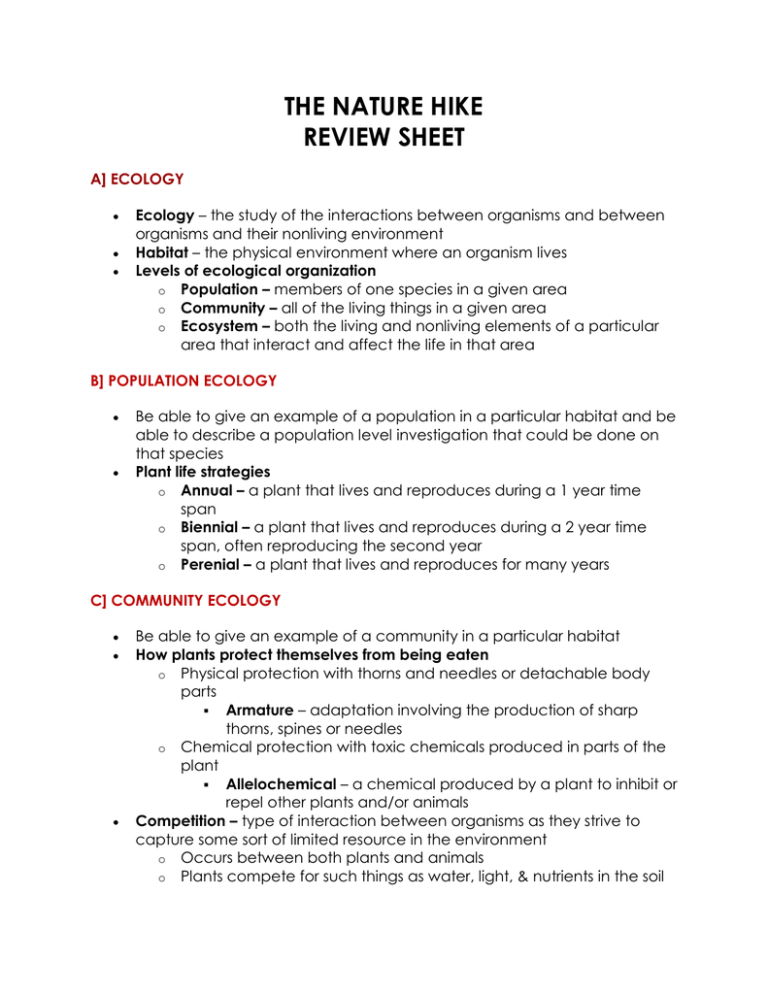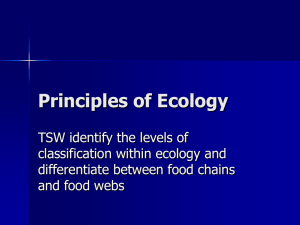03_NATURE HIKE F13NEW(1)
advertisement

THE NATURE HIKE REVIEW SHEET A] ECOLOGY Ecology – the study of the interactions between organisms and between organisms and their nonliving environment Habitat – the physical environment where an organism lives Levels of ecological organization o Population – members of one species in a given area o Community – all of the living things in a given area o Ecosystem – both the living and nonliving elements of a particular area that interact and affect the life in that area B] POPULATION ECOLOGY Be able to give an example of a population in a particular habitat and be able to describe a population level investigation that could be done on that species Plant life strategies o Annual – a plant that lives and reproduces during a 1 year time span o Biennial – a plant that lives and reproduces during a 2 year time span, often reproducing the second year o Perenial – a plant that lives and reproduces for many years C] COMMUNITY ECOLOGY Be able to give an example of a community in a particular habitat How plants protect themselves from being eaten o Physical protection with thorns and needles or detachable body parts Armature – adaptation involving the production of sharp thorns, spines or needles o Chemical protection with toxic chemicals produced in parts of the plant Allelochemical – a chemical produced by a plant to inhibit or repel other plants and/or animals Competition – type of interaction between organisms as they strive to capture some sort of limited resource in the environment o Occurs between both plants and animals o Plants compete for such things as water, light, & nutrients in the soil The environment is broken into areas that have different resources and these can be considered microhabitats o Microhabitats can allow a great diversity of organisms to occur in a given area, each better at living in one microhabitat than another o Examples of microhabitat differences In bright light vs. shade; at wet bottom of hill vs. dry top; in rocky soil vs. soil with lots of compost included, etc. Mowed areas vs. areas left alone by humans; areas that are watered by humans vs. those that are not, etc. Area contains organisms that like to eat a certain kind of plant or animal vs. those without such predators o Invasive species – a species introduced into a geographical area where it was not originally found and which thrives and spreads in the new area, almost “out-of-control” o Competitive exclusion principle – if two species are competing with one another for the same limited resource, the species able to use that resource most efficiently will eventually eliminate the other species in that location Symbiosis – the condition in which two or more dissimilar organisms live together in close association o Mutualism – a symbiotic relationship in which both participating species benefit Example 1: legumes & nitrogen fixing bacteria Legume – type of plant that includes such common plants as beans, peas, soybeans, alfalfa, clover and crown vetch Plants have specialized nodules on their roots produced by the plants that provide housing and moisture to the bacteria The bacteria are able to change nitrogen found in the air into nitrogen compounds that act as fertilizer to the plants Both species benefit Example 2: lichens Lichens are a composite organism composed of both algae and fungus The algae part can undergo photosynthesis and help feed the fungus The fungus helps to provide housing and moisture needed by the algae Both species benefit Example 3: insect pollination of flowers Insect pollination vs. wind pollination – be able to describe the difference we would expect to see in these plants’ o flowers and be able to identify which pollination mechanism is used if you are shown a flower o Parasitism – a symbiotic relationship in which one species benefits while the other species is harmed Example: tree and wild grape vine The tree spends a great deal of energy and resources to build a trunk to get its leaves high into the air The grape vine climbs up the trunk and takes advantage of the tree’s trunk to get its leaves high into the air The tree is harmed by the blocking of light caused by the grape leaves, the energy it needs to support the grape vines on its trunk and branches, and by the water taken from the immediate surroundings of its root system by the parasitic vine Ecological succession – the change in communities of life in an area over time after disturbance has occurred o Secondary succession – the re-colonization of an area that had life previously and the area is disturbed by man-made or natural events o Primary succession – the process where life moves into an area that previously did not have life o Sedimentation – the gradual filling in of a body of water from the accumulation of organic materials (dead animals & plants) Sedimentation can be greatly accelerated by algae blooms – the rapid growth of algae in a body of water that occurs when nutrients (such as fertilizers or animal feces) are introduced Fossils o Common rock in this area is called limestone and it often contains a wealth of fossilized organisms from this area’s distant past o Geological timetable – timeline of the history of geological and biological events of Earth’s history Era – largest (major) subdivision of the timetable, usually the history of life is divided into 5 Eras Pre-Cambrian Era Paleozoic Era Mesozoic Era Cenozoic Era The common fossils in this area are from the Paleozoic Era (505-430 million years ago) o Most common fossils around the Cincinnati area: brachiopods and bryozoa [be able to recognize and identify] D] ECOSYSTEM ECOLOGY Energy transfer in the living world – trophic relationships (feeding relationships) o Producers (autotrophs) – organisms that make their own food through the process of photosynthesis (e.g. green plants) o Primary consumers – next trophic level, the organisms that get their energy by eating plants (e.g. herbivores) o Secondary consumers – next trophic level, the organisms that get their energy by eating primary consumers (e.g. carnivores) o Decomposers – the last trophic level that involves organisms that break down dead organisms and the waste products of organisms into simple molecules that can then be used as building materials for producers (e.g. bacteria & fungi) Human impact on the ecosystem – introduction of pollutants o Nonpoint pollution – pollution that enters the environment from widespread origins, especially as the result of runoff after rain o Be able to give examples of human initiatives on campus to support and help the campus, community, and national environment (“green” initiatives)





